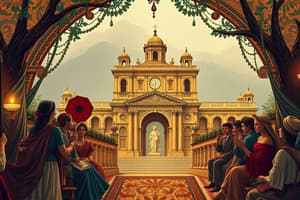Podcast
Questions and Answers
¿Qué caracteriza la contribución de Orozco al movimiento muralista?
¿Qué caracteriza la contribución de Orozco al movimiento muralista?
La profundidad emocional y el comentario social.
¿Cómo se caracteriza el muralismo de David Alfaro Siqueiros?
¿Cómo se caracteriza el muralismo de David Alfaro Siqueiros?
Por un enfoque más experimental y moderno.
¿Qué elementos definen el estilo del muralismo mexicano?
¿Qué elementos definen el estilo del muralismo mexicano?
Uso expressionista del color, pinceladas audaces y calidad narrativa.
¿Cuál es la relevancia actual del muralismo mexicano?
¿Cuál es la relevancia actual del muralismo mexicano?
¿Por qué el tamaño masivo de los murales era importante para los muralistas?
¿Por qué el tamaño masivo de los murales era importante para los muralistas?
¿Qué aspecto del muralismo mexicano sigue siendo importante para la cultura mexicana?
¿Qué aspecto del muralismo mexicano sigue siendo importante para la cultura mexicana?
¿Cuál es el movimiento artístico que destaca en la cultura mexicana?
¿Cuál es el movimiento artístico que destaca en la cultura mexicana?
¿Qué evento histórico impulsó la aparición del muralismo mexicano en el siglo XX?
¿Qué evento histórico impulsó la aparición del muralismo mexicano en el siglo XX?
¿Quiénes son algunos de los artistas destacados del muralismo mexicano?
¿Quiénes son algunos de los artistas destacados del muralismo mexicano?
¿Qué artista es conocido por su compromiso con la justicia social y la herencia indígena en sus murales?
¿Qué artista es conocido por su compromiso con la justicia social y la herencia indígena en sus murales?
¿Cómo se describe el estilo de Jose Clemente Orozco en sus murales?
¿Cómo se describe el estilo de Jose Clemente Orozco en sus murales?
¿Dónde se encuentra el icónico Mural de la Revolución de Diego Rivera?
¿Dónde se encuentra el icónico Mural de la Revolución de Diego Rivera?
Flashcards are hidden until you start studying
Study Notes
Unleashing Mexican Muralism: A Visual Revolution
In the vibrant tapestry of Mexican culture, muralism stands out as a profound artistic movement that intertwines history, politics, and social commentary. This article will delve into the heart of Mexican muralism, focusing on its origins and the artists who contributed to this monumental era.
Origins: A Political and Social Call to Action
Mexican muralism emerged in the early 20th century as a response to the Mexican Revolution, which sought to create a national identity and promote social justice. Led by notable figures such as Diego Rivera, Jose Clemente Orozco, and David Alfaro Siqueiros, Mexican muralism gained worldwide recognition for its politically charged imagery and iconic proportions.
The Big Three: A Legacy of Artistic Greatness
Diego Rivera
One of the most iconic artists of Mexican muralism, Diego Rivera is widely celebrated for his monumental works. His murals, such as the iconic Mural of the Revolution at the National Palace in Mexico City, demonstrate not only Rivera's artistic talent but also his profound commitment to social justice and indigenous heritage.
Jose Clemente Orozco
Jose Clemente Orozco's dramatic and expressionistic style captures the spirit of the Mexican Revolution and the despair of its aftermath. Works such as The Epic of Mexican Independence at the National Autonomous University of Mexico (UNAM) and The Struggle at the University of Guadalajara, showcase the emotional depth and the social commentary that characterized Orozco's contribution to the muralist movement.
David Alfaro Siqueiros
David Alfaro Siqueiros' muralism is characterized by a more experimental and modern approach. His futuristic and visually dynamic style, as seen in works such as American Tropical at the National Palace in Mexico City, remains as influential today as it was in the early 20th century.
The Muralist Style
Mexican muralism is defined by its unique style, which often combines an expressionistic use of color, bold brushstrokes, and a narrative quality that tells a story. The massive size of these works, often spanning hundreds of square meters, served to underscore the grandiose themes of the muralists' creations.
The Relevance of Mexican Muralism Today
While Mexican muralism emerged as a response to the socio-political realities of the early 20th century, its legacy persists in the art world. The themes of social justice, indigenous heritage, and historical awareness that characterized Mexican muralism continue to inspire contemporary artists and art movements.
Moreover, the muralists' use of public spaces to engage with society through art remains an important aspect of Mexican culture. The murals of Rivera, Orozco, and Siqueiros—as well as those of their contemporaries—continue to draw the attention of locals and tourists alike, showcasing the artistic and historical significance of Mexican muralism.
As an artistic movement, Mexican muralism remains a testament to the power of art to shape society, inspire change, and preserve the legacy of historical events. The muralists' bold and powerful works continue to resonate with viewers, reminding us of the transformative potential of artistic expression.
Studying That Suits You
Use AI to generate personalized quizzes and flashcards to suit your learning preferences.




